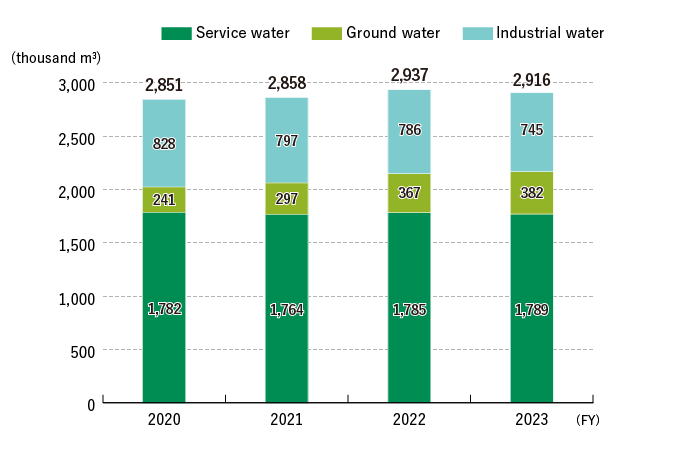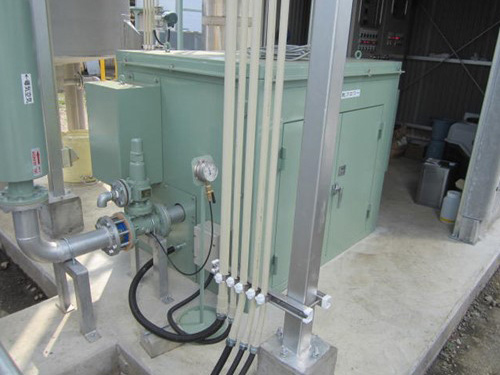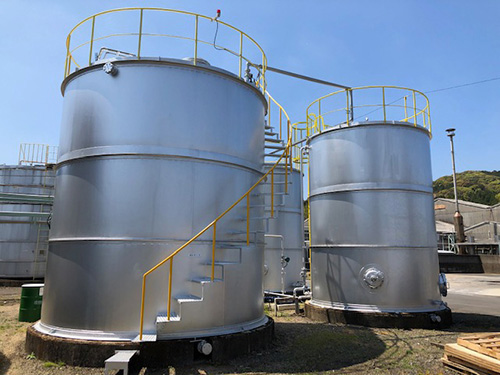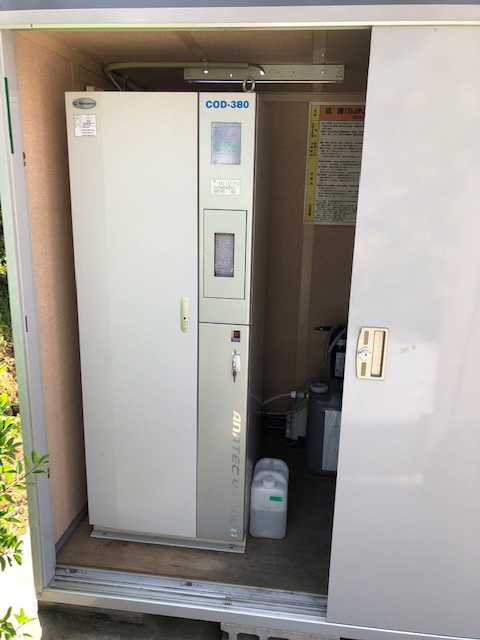- Home
- Sustainability
- Environment
- Efficient Use of Water Resources
Efficient Use of Water Resources
Reduction of Water Consumption in Business Activities
Around the world, there is a growing sense of crisis over water shortages. It is expected that this problem will become more and more urgent as the demand for water rises with population increase and economic growth in developing countries.
The primary businesses of the Sumitomo Forestry Group include the Timber and Building Materials Business and the Housing Business, which operate on a business model that does not use a high-volume of water. However, our businesses are expanding into sectors that do use water as a valuable resource. Our policy is to reduce the amount of water used with emphasis on these businesses while conducting risk assessments and examining countermeasures for problems that arise.
Management of Water Use in Business
In addition to manufacturing plants inside and outside Japan, since fiscal 2012, the Sumitomo Forestry Group has begun examining the consumption of water and the associated sources at bases where actual water usage is measurable, such as at buildings owned by the Sumitomo Forestry Group. We discovered 91.8% of water use is at eight group companies which make up 7.2% of the consolidated net sales by analyzing the water use of all Group companies in fiscal 2016. Therefore, we have positioned these eight companies as important water management companies and first conducted risk assessments for water use at five companies in Japan and brought together specific measures to address any cases of insufficient water. The Sumitomo Forestry Group has also begun to grasp the actual state of water use even at three overseas companies that use large amounts of water.
From fiscal 2016 to fiscal 2018, our water consumption increased significantly due to the operation of the Mombetsu Biomass Power Generation Plant and Hachinohe Biomass Power Generation Plant. Biomass power generation leads to increased water usage because power is generated by burning wood and other biomass fuel to boil water and create steam for powering turbines.
The Mid-Term Sustainability Targets set targets for Group-wide water consumption and manages progress. In fiscal 2023, the Group's total water consumption was 2,916 thousand m3. 22 thousand m3 less than in 2022. Adjustment in production of overseas manufacturing factories and suppression in use of water were main reasons. At Sumitomo Forestry Crest's Imari Plant, thorough water-saving measures to recycle industrial water and the replacement of waste fluid treatment equipment have led to a steady reduction in water consumption. At the Mombetsu Biomass Electric Power, an activity target was set to reduce water consumption in production activities, and the monitoring and management of water consumption was strengthened. In the future, efforts will be made to reach the 2024 target figure of 2,777 thousand m3 or less.
Sumitomo Forestry conducts sample surveys of water used by partner companies at on-site construction of houses in fiscal 2015 to grasp the water consumption in the supply chain, which found the volume of water used per 1m² of floor area is approximately 0.0887m³.
Water Consumption* (consolidated)

Water Consumption per Department*
| Office Departments in Japan,etc. (Unit:1,000m3) |
Plants and Power Generation
Business Departments in Japan
(Unit:1,000m3) |
Overseas Plants
(Unit:1,000m3) |
Total (Unit:1,000m3) |
|||||||
|---|---|---|---|---|---|---|---|---|---|---|
| FY2021 | FY2022 | FY2023 | FY2021 | FY2022 | FY2023 | FY2021 | FY2022 | FY2023 | FY2023 | |
| Service water | 87 | 80 | 102 | 1,337 | 1,341 | 1,337 | 340 | 364 | 350 | 1,789 |
| Ground water | 52 | 54 | 52 | 8 | 8 | 13 | 238 | 305 | 318 | 382 |
| Industrial water | 113 | 124 | 113 | 431 | 416 | 418 | 253 | 246 | 214 | 745 |
| Total | 252 | 258 | 266 | 1,776 | 1,765 | 1,768 | 831 | 912 | 882 | 2,916 |
*Covers sites where actual water consumption is measurable, such as at buildings owned by the Sumitomo Forestry Group.
Efforts in Sumitomo Forestry Crest
The Imari Plant of Sumitomo Forestry Crest, which manufactures such products as synthetic resin adhesives, uses industrial water to cool its manufacturing equipment. Afterwards, this water is reused to dilute factory wastewater and for other purposes as a water-conservation measure. In addition, from fiscal 2018, wastewater (coagulation sedimentation treated water) is further treated biologically to control the amount of water necessary for dilution for factory wastewater water quality management. This and other new water-saving measures led to an industrial water usage of 54,750m3 in fiscal 2023, a 63% decline compared to fiscal 2018.

Biological processing facility (aeration blower)

Biological processing facility (aeration tank)

Measuring the COD of effluent
Measures Used at the Sumitomo Forestry Crest's Imari Plant for Saving Water
・Subjecting waste water (after processing for coagulating sedimentation) to further biological processing*1 makes it possible to restrict the water used for dilution in plant waste water quality management (approximately 350m3/day).
・Maintain water-quality control by measuring COD*2 and treat wastewater using only the minimum amount of water necessary.
・After water is used to cool manufacturing equipment, it is used to dilute plant waste water.
・Improve the proportion of rainwater used, such as by upgrading the pumps used for collecting rainwater.
*1Beneficial microorganisms are supplied with air (oxygen), whereupon they absorb and break down organic substances, lowering COD values.
*2Chemical Oxygen Demand (COD): An indication of the amount of oxygen required to oxidize an organic compound in water; one of the most important indicators of water quality.
Housing Business Initiatives
Water-saving toilets, showers, and water faucet are recommended as standard equipment for new custom-built detached houses. Since 2016, we have been making efforts including installation of rainwater tanks to part of commercial products, and improving customers’ awareness of water saving and creation of related product line-up.
Water Intake Amount from Areas with Water Stress
| FY2023 | |
|---|---|
| Water intake amount from areas with water stress* | 521,757m3 |
*Water intake amount data (KTI, ASTI, VECO) of sites determined to be Sensitive sites in Locate phase of TNFD and LEAP analysis
Participation in Relevant Incentives
The Sumitomo Forestry Group provides answers to the CDP Water Security questions and discloses more detailed information about efforts on risks related to water since fiscal 2017.
- Home
- Sustainability
- Environment
- Efficient Use of Water Resources

